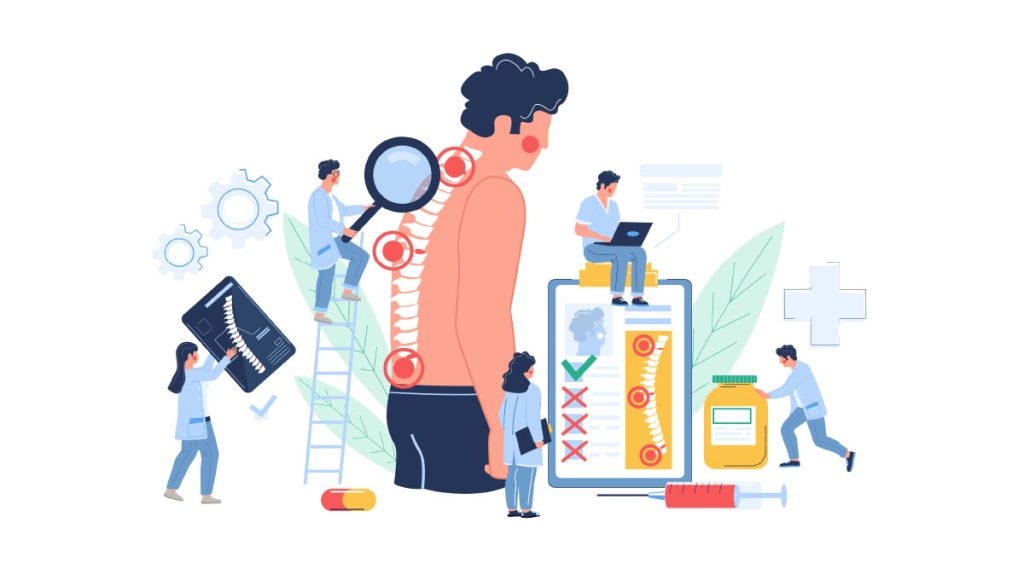Lower back pain is one of the most common reasons people visit healthcare providers. It can be caused by many different conditions, injuries or diseases, even underlying chronic conditions, but most often it is the result of injury to muscles or tendons in the back.
About the Lower Back

The spine is made up of 24 separate bones called vertebrae, which are stacked one on top of the other. The lumbar spine, located in the lower back, consists of a number of these vertebrae. It plays a crucial role in supporting the weight of the upper body. Everyday movements such as twisting, bending and managing the muscles in the pelvis, hips, legs and feet are also governed by the lumbar spine. The nerves, disks, cartilage between the disks, ligaments, muscles and bones in the lumbar spine are therefore susceptible to wear, tear and injury over time, sometimes resulting in lower back pain. At the bottom of the spine, below the vertebrae, are the sacrum and coccyx bones.
Lower Back Pain Symptoms
Lower back pain is sometimes referred to as lumbosacral pain or lumbago.
Symptoms of lower back pain may appear both suddenly or gradually. Pain may occur after a specific event, such as bending or twisting the spine, perhaps with an audible “pop” at the time of incidence, or the cause of pain may be unknown. Lower back pain may be sharp, presenting as muscle spasms or stiffness, or it may be felt as a dull ache, perhaps in the hips and/or pelvis. The pain may worsen with sitting, rapidly improve while walking, or be noticeably worse in the morning. Pain may also affect posture, making it hard to stand up straight. Pain may also radiate down the buttocks and back of the legs, which may indicate a condition known as sciatica.

Potential Causes of Lower Back Pain
Many different injuries, conditions or diseases may be the causes of lower back pain. These include:
Mechanical or functional injuries: Strains and sprains to muscles, tendons and ligaments are the most common causes of lower back pain, resulting in roughly 97% of all incidences.
Fractures: Breaks to the spine may occur in traumatic injury, or as the result of certain conditions such as spondylolysis or osteoporosis which increase the risk of fractures.
Disk issues: Complex disks made largely of cartilage and a gelatinous core are cushioned between the spinal vertebrae. Disks may bulge from their positions and press on nerves, flatten over time and offer less protection (degenerative disk disease), or tear (known as a herniated disk), resulting in lower back pain.
Arthritis: Osteoarthritis or “wear and tear” arthritis is a common cause of inflammation, stiffness and pain in the lower back.
More information on structural problems such as spinal stenosis, diseases that cause direct or referred pain such as kidney stones, and a condition called spondylolisthesis involving slipped vertebrae can be found in the following articles outlining back pain specific to men and women.
Non-Specific Lower Back Pain
It is not always possible to identify causes of lower back pain, and lumbago often remains undiagnosed as a result. Strains and sprains are usually responsible, but a number of symptoms may contribute and result in ongoing chronic back pain.
While it may be difficult to pinpoint the source of pain when looking for relief, certain risk factors may help with causation. Both manual jobs that include lifting and pulling movements, or twisting of the spine, and sedentary jobs that render workers desk bound, put individuals at risk of lower back pain. Smoking, being obese or inactive, having a demanding job or being overtly stressed, standing for a long time or suffering with depression may also contribute to lower back pain.
When to Seek Help
Lower back pain is regularly resolved on its own over time, but in some instances you may need to seek help for your lumbago. If pain lasts four weeks or longer, gets worse over time or is present alongside other symptoms such as fever, considerable weight gain or loss, bladder issues or loss of function in extremities, medical attention should be sought out.
